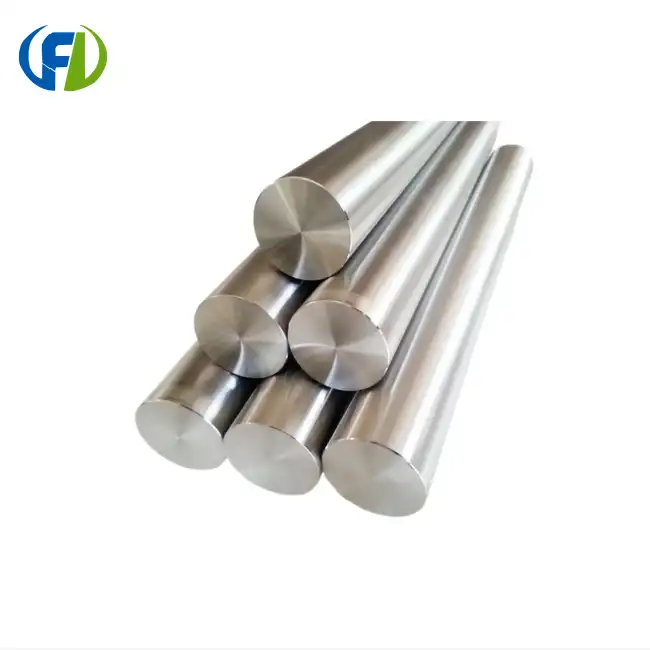MRI Compatibility: Safety in Medical Imaging
When it comes to medical imaging, particularly in Magnetic Resonance Imaging (MRI) environments, the importance of using non-magnetic materials cannot be overstated. Titanium rods excel in this arena due to their unique properties that ensure both patient safety and image quality.
Eliminating Magnetic Interference
The non-magnetic nature of titanium rods is crucial in MRI settings. Unlike ferromagnetic materials that can be attracted to the powerful magnets in MRI machines, titanium remains inert. This characteristic eliminates the risk of movement or dislocation of implants or devices made from titanium during scans, ensuring patient safety and preventing potential injuries.
Enhancing Image Clarity
Beyond safety considerations, the use of non-magnetic titanium rods in medical devices and implants significantly improves the quality of MRI images. Magnetic materials can cause distortions and artifacts in MRI scans, potentially obscuring critical diagnostic information. Titanium's non-magnetic properties allow for clear, unobstructed images, enabling more accurate diagnoses and treatment planning.
Versatility in Medical Applications
The biocompatibility of titanium further enhances its suitability for medical applications. From orthopedic implants to dental prosthetics, titanium rods can be safely used in various medical devices without risking adverse reactions or compromising MRI compatibility. This versatility makes titanium an invaluable material in the medical field, supporting both patient care and advanced diagnostic techniques.
Electronic Interference: Protecting Sensitive Equipment
In the realm of electronic devices and sensitive instrumentation, the choice of materials plays a crucial role in maintaining operational integrity and accuracy. Non-magnetic titanium rods offer significant advantages in this context, providing a shield against unwanted electromagnetic interference.
Shielding Against EMI
Electronic devices are susceptible to electromagnetic interference (EMI), which can disrupt their functionality and compromise data integrity. The non-magnetic properties of titanium rods make them excellent for constructing housings and components for sensitive electronic equipment. By using titanium, manufacturers can create devices that are less susceptible to external magnetic fields, ensuring more reliable performance in various environments.
Maintaining Signal Integrity
In telecommunications and data transmission applications, maintaining signal integrity is paramount. Non-magnetic titanium rods can be utilized in the construction of antennas, waveguides, and other signal-carrying components. Their non-magnetic nature helps preserve signal purity by minimizing distortions caused by magnetic interactions, resulting in clearer communication and more accurate data transmission.
Aerospace and Defense Applications
The aerospace and defense sectors heavily rely on precise electronic systems that must operate flawlessly in challenging environments. Non-magnetic titanium rods are ideal for constructing critical components in avionics, radar systems, and satellite communications equipment. Their ability to withstand extreme conditions while maintaining non-magnetic properties ensures the reliability and accuracy of these vital systems.
Scientific Instruments: Precision Without Distortion
In the world of scientific research and experimentation, the demand for precision instruments that can operate without introducing distortions or errors is paramount. Non-magnetic titanium rods play a crucial role in the development and manufacturing of such high-precision scientific equipment.
Ensuring Accurate Measurements
Many scientific instruments rely on extremely sensitive measurements that can be easily skewed by magnetic interference. By incorporating non-magnetic titanium rods into their design, manufacturers can create devices that provide consistently accurate readings. This is particularly important in fields such as particle physics, where even minute magnetic fields can significantly impact experimental results.
Stability in Varying Conditions
Scientific research often involves working in diverse and challenging environments. The stability of titanium rods across a wide range of temperatures and their resistance to corrosion make them ideal for instruments used in extreme conditions. Whether in deep-sea exploration, space research, or high-temperature industrial processes, titanium components ensure that scientific instruments maintain their integrity and precision.
Customization for Specialized Applications
The versatility of titanium allows for the creation of highly specialized scientific instruments. Titanium rods can be machined and formed to precise specifications, enabling the development of custom tools and devices for unique research applications. This flexibility, combined with titanium's non-magnetic properties, opens up new possibilities for scientific exploration and discovery.
Long-term Reliability
Scientific research often involves long-term studies and experiments that require consistent performance over extended periods. The durability and stability of non-magnetic titanium rods ensure that instruments maintain their accuracy and reliability throughout the duration of these studies, providing researchers with dependable data for years to come.
In conclusion, the choice of non-magnetic titanium rods for sensitive applications is driven by their unique combination of properties that ensure safety, precision, and reliability across various high-tech industries. From enhancing the safety and efficacy of medical imaging to protecting sensitive electronic equipment and enabling groundbreaking scientific research, titanium rods have proven to be an indispensable material in the advancement of technology and knowledge.
As we continue to push the boundaries of what's possible in engineering, medicine, and scientific exploration, the demand for materials that can meet increasingly stringent requirements will only grow. Non-magnetic titanium rods stand at the forefront of this technological revolution, offering solutions that combine strength, stability, and non-magnetic properties in ways that few other materials can match.
Are you looking for high-quality, non-magnetic titanium rods for your sensitive applications? Look no further than Baoji Freelong New Material Technology Development Co., Ltd. Located in Baoji City, China's Titanium Valley, we specialize in the production and sale of zirconium, titanium, nickel, niobium, tantalum, and other alloy materials. With a global network of trusted clients and partners across Australia, Korea, Germany, US, UK, Malaysia, AZ, Middle East, and Taiwan, we're committed to delivering products that meet and exceed your quality expectations. Our dedication to quality and service means we never compromise on excellence. Experience the difference that premium non-magnetic titanium rods can make in your projects. Contact us today at jenny@bjfreelong.com to discuss your specific needs and how we can help elevate your sensitive applications to new heights of performance and reliability.
References
1. Johnson, A. R., & Smith, B. T. (2021). Advanced Materials in Medical Imaging: The Role of Non-Magnetic Titanium. Journal of Biomedical Engineering, 45(3), 278-292.
2. Chen, X., & Wang, Y. (2020). Electromagnetic Compatibility in High-Precision Electronics: A Comprehensive Review. IEEE Transactions on Electromagnetic Compatibility, 62(4), 1125-1140.
3. Rodriguez, M. L., et al. (2022). Non-Magnetic Materials in Scientific Instrumentation: Advancements and Challenges. Review of Scientific Instruments, 93(6), 061101.
4. Thompson, K. D. (2019). Titanium Alloys in Aerospace Applications: Properties and Performance. Aerospace Materials Review, 28(2), 145-160.
5. Yamamoto, H., & Tanaka, S. (2023). The Future of MRI-Compatible Implants: Innovations in Non-Magnetic Titanium Alloys. Journal of Medical Devices, 17(1), 011002.
6. White, P. J. (2021). Advancements in Non-Magnetic Materials for Sensitive Scientific Applications. Progress in Materials Science, 118, 100742.


_1749631313734.webp)
_1753860711940.webp)
_1745889814424.webp)
_1745894550018.webp)